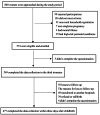Pre- and postpartum fear of childbirth and its predictors among rural women in China
- PMID: 38816809
- PMCID: PMC11138059
- DOI: 10.1186/s12884-024-06585-x
Pre- and postpartum fear of childbirth and its predictors among rural women in China
Abstract
Background: Fear of childbirth (FOC) can influence both maternal and child health. Research on FOC in China is scarce, especially on rural women. This study aimed to assess pre- and postpartum FOC and its predictors among Chinese rural women.
Methods: This was a prospective correlation study. A total of 569 women completed the prenatal questionnaire in the third trimester, and 477 of them completed the postpartum questionnaire within three days after childbirth. Maternal socio-demographic information, clinical information, childbirth self-efficacy and prenatal and postpartum FOC were investigated. FOC was evaluated using the Wijma Childbirth Expectancy/ Experience Questionnaire (WDEQ). Descriptive, bivariate, multivariate linear regression analysis, univariate and multivariate logistic regression analyses were performed.
Results: The mean pre- and postpartum FOC scores were 64.5 (standard deviation: 25.1) and 64.3 (standard deviation: 23.9), respectively, with 20.8% of women reporting severe fear before childbirth and 18.2% after childbirth. Multivariate linear regression analysis revealed predictors for higher levels of prenatal FOC including higher education level, nullipara, higher monthly household income, lower family support, and lower childbirth self-efficacy (p < 0.05) and the predictors for higher levels of postpartum FOC included unemployed status, lower childbirth self-efficacy, and higher prenatal FOC (p < 0.05). Multivariate logistic regression showed that higher childbirth self-efficacy reduced the likelihood of severe prenatal FOC (OR: 0.99, p < 0.001), while severe prenatal FOC increased the likelihood of severe postpartum FOC (OR: 3.57, p < 0.001).
Conclusion: The rural women have high levels of FOC before and after childbirth, with approximately 20% experiencing severe FOC during both periods. Higher education level, nullipara, higher monthly household income, lower family support, and lower childbirth self-efficacy are predictors of heightened prenatal FOC. Unemployed status, lower childbirth self-efficacy, and higher prenatal FOC are predictors of heightened postpartum FOC. Notably, enhancing childbirth self-efficacy emerges as crucial in mitigating severe prenatal FOC, while severe prenatal FOC significantly increases the likelihood of severe postpartum FOC. The development of targeted intervention strategies for the above factors can help reduce women's FOC level and improve their overall pregnancy and childbirth experience.
Keywords: Childbirth; Fear; Postpartum; Prenatal; Rural women.
© 2024. The Author(s).
Conflict of interest statement
The authors declare no competing interests.
Similar articles
-
The prevalence and predictors of fear of childbirth among pregnant Chinese women: a hierarchical regression analysis.BMC Pregnancy Childbirth. 2021 Sep 22;21(1):643. doi: 10.1186/s12884-021-04123-7. BMC Pregnancy Childbirth. 2021. PMID: 34551755 Free PMC article.
-
Fear of childbirth and associated factors among low-risk pregnant women.J Obstet Gynaecol. 2019 Aug;39(6):763-767. doi: 10.1080/01443615.2019.1584885. Epub 2019 Apr 22. J Obstet Gynaecol. 2019. PMID: 31007101
-
'I've Changed My Mind', Mindfulness-Based Childbirth and Parenting (MBCP) for pregnant women with a high level of fear of childbirth and their partners: study protocol of the quasi-experimental controlled trial.BMC Psychiatry. 2016 Nov 7;16(1):377. doi: 10.1186/s12888-016-1070-8. BMC Psychiatry. 2016. PMID: 27821151 Free PMC article.
-
Interventions for fear of childbirth including tocophobia.Cochrane Database Syst Rev. 2021 Jul 7;7(7):CD013321. doi: 10.1002/14651858.CD013321.pub2. Cochrane Database Syst Rev. 2021. PMID: 34231203 Free PMC article.
-
Fear and Anxiety Disorders Related to Childbirth: Epidemiological and Therapeutic Issues.Curr Psychiatry Rep. 2019 Mar 12;21(4):27. doi: 10.1007/s11920-019-1010-7. Curr Psychiatry Rep. 2019. PMID: 30868272 Review.
Cited by
-
The relationship between fear of birth and prenatal attachment and childbirth self-efficacy perception in Primigravida women.BMC Pregnancy Childbirth. 2025 Apr 21;25(1):462. doi: 10.1186/s12884-025-07555-7. BMC Pregnancy Childbirth. 2025. PMID: 40259226 Free PMC article.
-
Investigating health literacy and its associations with fear of childbirth in pregnant women: a cross-sectional study.Sci Rep. 2025 Jul 18;15(1):26191. doi: 10.1038/s41598-025-11954-3. Sci Rep. 2025. PMID: 40681710 Free PMC article.
-
Construction and Validation of a Model for Predicting Fear of Childbirth: A Cross-Sectional Population Study via Machine Learning.Int J Womens Health. 2025 Feb 6;17:311-323. doi: 10.2147/IJWH.S508153. eCollection 2025. Int J Womens Health. 2025. PMID: 39931669 Free PMC article.
-
Psychological dilemmas and distress among Chinese primiparas during the postpartum transition underlying implicit cultural norms: a phenomenological inquiry.BMC Psychol. 2025 Aug 13;13(1):911. doi: 10.1186/s40359-025-03264-0. BMC Psychol. 2025. PMID: 40804653
References
MeSH terms
Grants and funding
LinkOut - more resources
Full Text Sources
Medical


